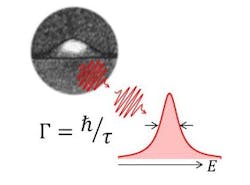Quantum dot emits indistinguishable single photons
Physicists at the University of Basel (Basel, Switzerland) and the University of Bochum (Bochum, Germany) have developed a semiconductor quantum-dot light source that emits single, identical photons.1
Single-photon sources are important in the field of quantum information technology where, for example, they are used in quantum computers. Alongside the brightness and robustness of the light source, the indistinguishability of the photons is especially crucial. In particular, this means that all photons must be precisely the same wavelength ("transform limited"). Creating such a source of identical single photons has proven very difficult in the past.
However, quantum dots made of semiconductor materials are offering new hope. Single electrons can be trapped inside a quantum dot and are confined on a nanometer scale. An individual photon is emitted when a quantum state decays.
Noise in the semiconductor helps indistinguishability
A team of scientists led by Andreas Kuhlmann and Richard Warburton from the University of Basel has already shown in past publications that the indistinguishability of the photons is reduced by the fluctuating nuclear spins of the quantum-dot atoms. Now, the scientists have controlled the nuclear spins to such an extent that even photons sent out widely separated in time (a timescale on the order of a second) are the same wavelength.
Quantum cryptography and quantum communication are two potential areas of application for single-photon sources.
REFERENCE:
1. Andreas V. Kuhlmann et al., Nature Communications (2015); doi: 10.1038/ncomms9204
About the Author
John Wallace
Senior Technical Editor (1998-2022)
John Wallace was with Laser Focus World for nearly 25 years, retiring in late June 2022. He obtained a bachelor's degree in mechanical engineering and physics at Rutgers University and a master's in optical engineering at the University of Rochester. Before becoming an editor, John worked as an engineer at RCA, Exxon, Eastman Kodak, and GCA Corporation.

